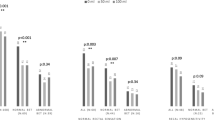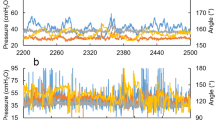PURPOSE
The intermittent loss of oil or stool (“spotting”) is an adverse effect that occurs in patients taking orlistat; the pathophysiology is unknown. This study was designed to investigate the local effects of orlistat, free fatty acids, and the effects of the physical properties of rectal contents on anorectal function and continence.
METHODS
Anorectal physiology and continence function were assessed in ten healthy patients after the application of four test enemas: 1) high-viscosity stool substitute, 2) stool substitute with free fatty acid, 3) low-viscosity oil with placebo, 4) oil with orlistat. Rectal function and capacity were assessed by barostat techniques. Anal resting pressure, squeeze pressure, and squeeze duration were assessed by manometry. A retention test was performed using the same enemas as a quantitative assessment of continence.
RESULTS
Orlistat and free fatty acid had no adverse effects on anorectal function or continence. For each enema, the maximum volume retained correlated with rectal capacity (r = 0.85; P < 0.01). Continence during rectal filling was better maintained for high-viscosity stool substitute than low-viscosity oil enemas (P < 0.03). Patients able to maintain effective squeeze pressure retained more of the low-viscosity enemas than those with short squeeze duration (P < 0.01); in contrast, the volume retained of high-viscosity enemas was unaffected by anal sphincter function.
CONCLUSIONS
The physical properties of rectal contents, rectal capacity, and voluntary anal sphincter function have effects on continence function in healthy patients. The occurrence of spotting may depend on both intrinsic anorectal function and the effects of orlistat on the volume and physical properties of stool.





Similar content being viewed by others
REFERENCES
JB Hauptman FS Jeunet D Hartmann (1992) ArticleTitleInitial studies in humans with the novel gastrointestinal lipase inhibitor Ro 18-0647 (tetrahydrolipstatin) Am J Clin Nutr 55 309S–13S Occurrence Handle1:CAS:528:DyaK38Xht1Sksbc%3D Occurrence Handle1728845
J Zhi AT Melia R Guerciolini et al. (1994) ArticleTitleRetrospective population-based analysis of the dose-response (fecal fat excretion) relationship of orlistat in normal and obese volunteers Clin Pharmacol Ther 56 82–5 Occurrence Handle1:STN:280:DyaK2czgs1ygtg%3D%3D Occurrence Handle8033498 Occurrence Handle10.1038/clpt.1994.104
L Sjostrom A Rissanen T Andersen et al. (1998) ArticleTitleRandomised placebo-controlled trial of orlistat for weight loss and prevention of weight regain in obese patients European Multicentre Orlistat Study Group. Lancet 352 167–72 Occurrence Handle1:CAS:528:DyaK1cXlt1altbo%3D
MH Davidson J Hauptman M DiGirolamo et al. (1999) ArticleTitleWeight control and risk factor reduction in obese subjects treated for 2 years with orlistat: a randomized controlled trial JAMA 281 235–42 Occurrence Handle1:CAS:528:DyaK1MXhtFSqtr8%3D Occurrence Handle9918478
S Rossner L Sjostrom R Noack AE Meinders G Noseda (2000) ArticleTitleWeight loss, weight maintenance, and improved cardiovascular risk factors after 2 years treatment with orlistat for obesity European Orlistat Obesity Study Group. Obes Res 8 49–61 Occurrence Handle1:CAS:528:DC%2BD3cXpvF2msQ%3D%3D
J Zhi AT Melia H Eggers R Joly IH Patel (1995) ArticleTitleReview of limited systemic absorption of orlistat, a lipase inhibitor, in healthy human volunteers J Clin Pharmacol 35 1103–8 Occurrence Handle1:CAS:528:DyaK28XkslWnsg%3D%3D Occurrence Handle8626884
HV Ammon SF Phillips (1973) ArticleTitleInhibition of colonic water and electrolyte absorption by fatty acids in man Gastroenterology 65 744–9 Occurrence Handle1:CAS:528:DyaE2cXisFagtQ%3D%3D Occurrence Handle4758971
RC Spiller ML Brown SF Phillips (1986) ArticleTitleDecreased fluid tolerance, accelerated transit, and abnormal motility of the human colon induced by oleic acid Gastroenterology 91 100–7 Occurrence Handle1:CAS:528:DyaL28XkvFGit7o%3D Occurrence Handle3710059
JJ Bannister P Davison JM Timms C Gibbons NW Read (1987) ArticleTitleEffect of stool size and consistency on defecation Gut 28 1246–50 Occurrence Handle1:STN:280:DyaL1c%2Fls1CrtA%3D%3D Occurrence Handle3678954
WL Ambroze JH Pemberton AM Bell ML Brown AR Zinsmeister (1991) ArticleTitleThe effect of stool consistency on rectal and neorectal emptying Dis Colon Rectum 34 1–7 Occurrence Handle1:STN:280:DyaK3M7itF2gtg%3D%3D Occurrence Handle1991415
M Fox M Thumshirn D Menne B Stutz M Fried W Schwizer (2004) ArticleTitleEvaluation of anorectal function in subjects receiving orlistat Aliment Pharmacol Ther 19 311–21 Occurrence Handle10.1111/j.1365-2036.2004.01848.x Occurrence Handle1:CAS:528:DC%2BD2cXisVWhsro%3D Occurrence Handle14984378
P Hadvary W Sidler W Meister W Vetter H Wolfer (1991) ArticleTitleThe lipase inhibitor tetrahydrolipstatin binds covalently to the putative active site serine of pancreatic lipase J Biol Chem 266 2021–7 Occurrence Handle1:CAS:528:DyaK3MXhsF2ltrw%3D Occurrence Handle1899234
WE Whitehead M Delvaux (1997) ArticleTitleStandardization of barostat procedures for testing smooth muscle tone and sensory thresholds in the gastrointestinal tract. The Working Team of Glaxo-Wellcome Research, UK Dig Dis Sci 42 223–41 Occurrence Handle10.1023/A:1018885028501 Occurrence Handle1:STN:280:DyaK2s3gsV2qsQ%3D%3D Occurrence Handle9052500
H Hammer A Phillips M Camilleri R Hanson (1998) ArticleTitleRectal tone, distensibility, and perception: reproducibilty and response to different distensions Am J Physiol Gastrointest Liver Physiol 274 G584–9 Occurrence Handle1:CAS:528:DyaK1cXitVGjtb0%3D
M Fox D Menne M Fried W Schwizer M Thumshirn (2003) ArticleTitleThe measurement of rectal capacity by barostat techniques Gut 52 A91 Occurrence Handle10.1136/gut.52.1.91
M Fox M Thumshirn D Menne M Fried W Schwizer (2004) ArticleTitleAnal sphincter pressure and rectal capacity affect anorectal sensation and continence in health Gastroenterology 126 M1578
NW Read WV Harford AC Schmulen MG Read C Ana ParticleSanta JS Fordtran (1979) ArticleTitleA clinical study of patients with fecal incontinence and diarrhea Gastroenterology 76 747–56 Occurrence Handle1:STN:280:DyaE1M7ivVKhsQ%3D%3D Occurrence Handle422003
NW Read DC Bartolo MG Read (1984) ArticleTitleDifferences in anal function in patients with incontinence to solids and in patients with incontinence to liquids Br J Surg 71 39–42 Occurrence Handle1:STN:280:DyaL2c%2FotFejuw%3D%3D Occurrence Handle6689968
R Miller DC Bartolo A Roe F Cervero NJ Mortensen (1988) ArticleTitleAnal sensation and the continence mechanism Dis Colon Rectum 31 433–8 Occurrence Handle1:STN:280:DyaL1c3kt1eltg%3D%3D Occurrence Handle3378467
K Bielefeldt P Enck N Zamboglou U Moedder JF Erckenbrecht (1991) ArticleTitleAnorectal manometry and defecography in the diagnosis of fecal incontinence J Clin Gastroenterol 13 661–5 Occurrence Handle1:STN:280:DyaK387gsFKluw%3D%3D Occurrence Handle1761839
ACKNOWLEDGMENTS
The authors thank Dr. Hans Lengsfeld (F. Hoffmann, La Roche Ltd., Basel, Switzerland) for his advice on study design and evaluation, and Professor Jim Brasseur (Department of Mechanical Engineering, Pennsylvania State University, University Park, Pennsylvania, United States) for his valuable insights into the biomechanics of rectal function.
Author information
Authors and Affiliations
Additional information
Supported by F. Hoffmann, La Roche Ltd., Basel, Switzerland.
About this article
Cite this article
Fox, M., Schwizer, W., Menne, D. et al. The Physical Properties of Rectal Contents Have Effects on Anorectal Continence: Insights From a Study Into the Cause of Fecal Spotting on Orlistat. Dis Colon Rectum 47, 2147–2156 (2004). https://doi.org/10.1007/s10350-004-0739-0
Published:
Issue Date:
DOI: https://doi.org/10.1007/s10350-004-0739-0




